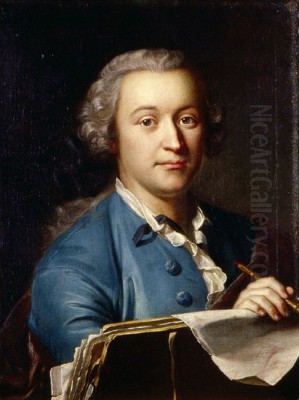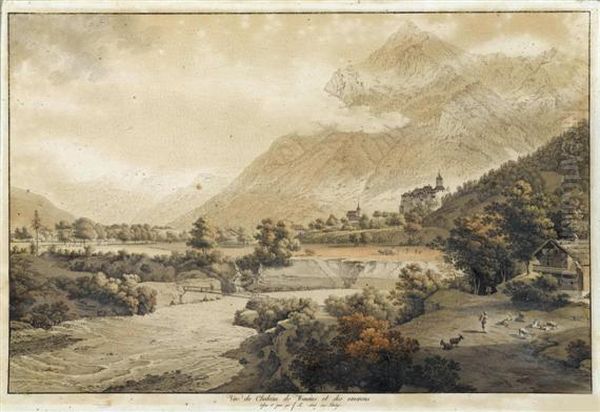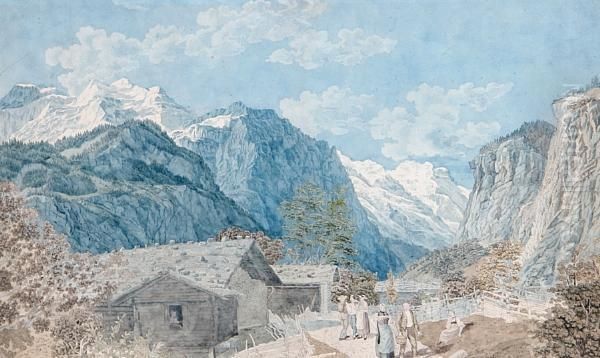
Johann Ludwig Aberli stands as a seminal figure in the history of Swiss art, particularly renowned for his evocative landscapes and his innovative approach to printmaking. Active during the 18th century, a period of burgeoning interest in the natural world and the rise of tourism, Aberli masterfully captured the sublime beauty of the Swiss Alps and the idyllic charm of its countryside. His work not only catered to a growing international clientele eager for souvenirs of their travels but also significantly influenced the trajectory of landscape art in Switzerland and beyond. Through his unique "Aberli Manière," a distinctive method of creating colored outline etchings, he made picturesque views accessible to a wider audience, leaving an indelible mark on the visual culture of his time.
Early Life and Artistic Formation
Born in Winterthur, Switzerland, on November 14, 1723, Johann Ludwig Aberli's artistic journey began in his youth. His initial training was likely local, but a pivotal moment came in 1741 when he moved to Bern. There, he became an apprentice to the painter Johann Grimm (1675-1747), a respected artist in the city. Under Grimm's tutelage, Aberli honed his skills in drawing and painting. Grimm's own work, often depicting local scenes and portraits, would have provided a solid foundation for Aberli's later specialization in landscape.
After Grimm's death in 1747, Aberli, by then a capable artist, took over his master's painting school. This role as an educator would have further solidified his own artistic principles and allowed him to mentor a new generation of artists. His early works from this period likely included various subjects, but his inclination towards landscape, particularly the scenic vistas around Bern and the majestic Alpine regions, began to define his artistic identity. The environment of Bern, with its stunning natural surroundings, undoubtedly played a crucial role in shaping his artistic vision.
The Innovation of the "Aberli Manière"

Perhaps Aberli's most significant contribution to art was the development of his signature technique, often referred to as the "Aberli Manière" or "Aberli Style." This innovative method, which he perfected in the 1760s, involved creating etchings with a clear, delicate outline. These prints were then meticulously hand-colored with watercolors, often by Aberli himself or by skilled artisans working in his studio. The result was a hybrid art form that combined the reproducibility of printmaking with the subtle tonalities and vibrant hues of watercolor painting.
This technique was revolutionary for its time. It allowed for the relatively swift production of multiple images that retained a high degree of artistic quality and the appearance of original watercolors. The outlines provided the structure and detail, while the hand-coloring added depth, atmosphere, and individual charm to each piece. The "Aberli Manière" was perfectly suited to capturing the nuanced beauty of Swiss landscapes, from the hazy blues of distant mountains to the fresh greens of pastoral valleys. This method made his art more accessible and affordable than unique oil paintings or watercolors, catering to the burgeoning market of tourists, particularly British travelers on the Grand Tour, who sought mementos of the sublime Swiss scenery.
The success of this technique was immediate and widespread. It not only brought Aberli considerable fame and commercial success but also inspired a school of followers who adopted and adapted his methods. Artists like Heinrich Rieter (1751-1818) became prominent practitioners of this colored outline etching style, further popularizing Swiss views across Europe.
Capturing the Swiss Picturesque: Themes and Subjects
Aberli's primary subject matter was the Swiss landscape, which he depicted with a keen eye for detail and a profound appreciation for its diverse beauty. He was particularly drawn to the Bernese Oberland, with its dramatic peaks, serene lakes, and charming villages. His works often feature iconic mountains like the Eiger, Mönch, and Jungfrau, as well as picturesque views of Lake Thun and Lake Brienz.
His landscapes were not merely topographical records; they were imbued with an idyllic and often romantic sensibility. He skillfully incorporated human elements – rustic chalets, grazing cattle, local figures in traditional dress – which added life and narrative interest to his scenes. This approach aligned with the 18th-century aesthetic of the "picturesque," which valued landscapes that were visually charming, varied, and suitable for depiction in art. Aberli's compositions were carefully structured, often leading the viewer's eye through layers of foreground, middle ground, and distant vistas, creating a sense of depth and immersion.

The popularity of his works was also fueled by the Enlightenment's growing interest in nature and the burgeoning Romantic movement, which celebrated the sublime and the emotional power of the natural world. Aberli's depictions of Switzerland offered a vision of nature that was both awe-inspiring and accessible, appealing to the intellectual and sentimental currents of the age. He also produced series of drawings depicting Swiss costumes, further catering to the ethnographic interests of his audience.
Travels and Artistic Development
While Aberli was based in Bern for most of his career, a significant journey in 1759 broadened his artistic horizons. He traveled to the Bernese Oberland, a region that would become a recurrent source of inspiration for his most famous works. This expedition was undertaken in the company of fellow artists, including Emanuel Handmann (1718-1781), a notable Swiss portraitist; Christian Georg Schütz the Elder (1718-1791), a German landscape painter known for his Rhine views; and Friedrich Wilhelm Hirt (1721-1772), another German artist. Such collaborative trips were common and allowed for the exchange of ideas and techniques.
Later that same year, Aberli made his only significant trip abroad, traveling to Paris. The French capital was then the undisputed center of the European art world. While details of his activities there are scarce, it is highly probable that he would have studied the works of leading French landscape painters like Claude Joseph Vernet (1714-1789), whose dramatic seascapes and landscapes were immensely popular, or perhaps the more pastoral scenes of artists influenced by the Rococo tradition. This exposure to different artistic styles and the vibrant Parisian art scene likely refined his technique and expanded his understanding of landscape composition.
Despite this international exposure, Aberli's artistic heart remained firmly rooted in Switzerland. His experiences abroad seem to have reinforced his commitment to depicting the unique character of his native land. One anecdote records his journey to the Joux Valley in 1774. While he reportedly found its beauty somewhat less overwhelming than the grandeur of the High Alps, he was nevertheless captivated by its "wildness," a sentiment that reflects the era's appreciation for untamed nature.
Representative Works: A Closer Look
Several works stand out in Aberli's extensive oeuvre, exemplifying his style and thematic concerns.
One of his most celebrated pieces is the Vue du Château de Wimmis et des environs (View of Wimmis Castle and its surroundings). This work, executed in his characteristic colored outline etching technique, showcases his mastery in rendering both architectural detail and expansive landscapes. Wimmis Castle, perched dramatically on a hill, is set against the backdrop of towering Alpine peaks. The careful application of watercolor brings out the textures of the stone, the foliage, and the atmospheric perspective of the distant mountains. The scene is animated by small figures, grounding the majestic view with a touch of human presence.
Another significant work, or rather a project, is his Voyage artistique à la Vallée de Joux fait en 1774 (Artistic Journey to the Joux Valley made in 1774). This likely refers to a series of views resulting from his visit. These depictions of the Joux Valley, while perhaps less overtly sublime than his Alpine scenes, would have highlighted the tranquil, pastoral beauty of the region. Such series of views were highly sought after, allowing collectors to acquire a visual narrative of a particular locale.
Beyond specific titles, Aberli's numerous series of hand-colored etchings depicting various Swiss locales – views of Bern, Lake Geneva, Interlaken, and the Rhine Falls, among others – collectively form his most important legacy. These prints, often sold individually or in albums, disseminated the image of Switzerland as a land of unparalleled natural beauty across Europe. Their consistent quality, charming execution, and the innovative "Aberli Manière" made them highly desirable. Many of these can be found in prestigious collections today, including the British Museum and various Swiss national and cantonal museums.
Teaching, Influence, and Collaborations
As the head of a painting school in Bern from 1747, Johann Ludwig Aberli played an important role in educating the next generation of artists. His students included figures such as Erasmus Ritter (1726-1805), Johann Jakob Bodmer II (1737-1806, not to be confused with the literary critic), Marie-Louise Labouret, Gabriel Lory père (1763-1840, though he would have been very young, his father or an early influence might be implied, or it could be Gabriel Wicky), and notably Samuel Hieronymus Grimm (1733-1794), often referred to by his middle name or the nickname "Marquard." Samuel Grimm, who later found considerable success in England as a watercolorist, would have absorbed Aberli's meticulous approach to landscape and detailed observation.
Aberli's influence extended beyond his direct pupils. His "Aberli Manière" was widely imitated and adapted. As mentioned, Heinrich Rieter was a key figure in continuing this tradition. Other artists who specialized in Swiss views, such as Adrian Zingg (1734-1816), who worked primarily in Dresden but depicted Saxon Switzerland with a similar picturesque sensibility, and Johann Jakob Biedermann (1763-1830), known for his idyllic landscapes and animal paintings, were part of this broader movement of popularizing landscape art.
Aberli also engaged in collaborations. He is known to have worked with Balthasar Anton Dunker (1746-1807), a painter and etcher of German origin who settled in Bern. Dunker, a versatile artist, likely assisted in the production of prints or collaborated on specific projects, bringing his own skills in etching to complement Aberli's vision. The collaborative nature of printmaking workshops was common, allowing for efficient production and the combination of different talents.
The broader artistic context of Switzerland at the time also included figures like the internationally renowned pastellist Jean-Étienne Liotard (1702-1789) from Geneva, and the influential poet-painter Salomon Gessner (1730-1788) from Zurich, whose idyllic literary and visual works celebrated a harmonious vision of nature and rural life. While their styles differed, they all contributed to a growing appreciation for Swiss art and landscape. Even portraitists like Anton Graff (1736-1813), though Swiss-born and trained, found great success in Germany, indicating the talent emerging from the region.
Later Life and Posthumous Recognition
Johann Ludwig Aberli continued to be productive throughout his life, managing his workshop and producing a steady stream of popular landscape views. His art catered to a diverse clientele, ranging from Swiss patricians and intellectuals to the ever-increasing number of foreign tourists. His keen business acumen, coupled with his artistic talent, ensured his financial stability and widespread reputation.
He died in Bern on October 17, 1786, at the age of 63. By the time of his death, he was one of Switzerland's most recognized artists. His legacy was twofold: he had created an enduring visual record of Switzerland's natural beauty, and he had pioneered an innovative and influential printmaking technique.
Even after his death, his influence persisted. His works continued to be collected and admired. In 1790, a posthumous exhibition of six of his landscapes was held at the Society of Artists in London, a testament to his international standing. The "Aberli Manière" remained a popular method for producing landscape views well into the 19th century, adapted by artists like the Lory family (Gabriel Lory père and his son, Mathias Gabriel Lory fils, 1784-1846), who produced highly finished aquatints that built upon the tradition Aberli had established.
The rise of Romanticism in the early 19th century saw an even greater fascination with Alpine scenery, and artists like Caspar Wolf (1735-1783), a contemporary who focused on more dramatic and scientifically accurate depictions of the Alps, also contributed to this genre. However, Aberli's particular blend of the picturesque, the idyllic, and the accessible held a unique appeal. Later, artists like Alexandre Calame (1810-1864) and even the French master Jean-Baptiste-Camille Corot (1796-1875), though working in different styles and with different sensibilities, were part of a continuing tradition of landscape painting that valued direct observation and the emotional resonance of nature, a path Aberli had helped to forge.
Conclusion: Aberli's Enduring Legacy
Johann Ludwig Aberli's importance in art history extends beyond his charming depictions of Swiss scenery. He was an innovator who understood the changing art market and the desires of a new class of art consumers. His "Aberli Manière" democratized access to art, allowing a broader public to own beautiful representations of the landscapes they admired or had visited. He effectively branded Swiss scenery, contributing significantly to the country's image as a premier tourist destination.
His meticulous attention to detail, combined with a gentle, often poetic, sensibility, created works that were both informative and aesthetically pleasing. He captured the essence of the Swiss picturesque, influencing not only his contemporaries and successors in Switzerland but also contributing to the wider European fascination with Alpine landscapes. As an artist, an innovator, and an educator, Johann Ludwig Aberli remains a key figure in 18th-century European art, whose work continues to delight and inform us about the landscapes and artistic currents of his time. His legacy is preserved in the numerous prints and drawings that survive, offering a timeless window onto the majestic and serene beauty of Switzerland.